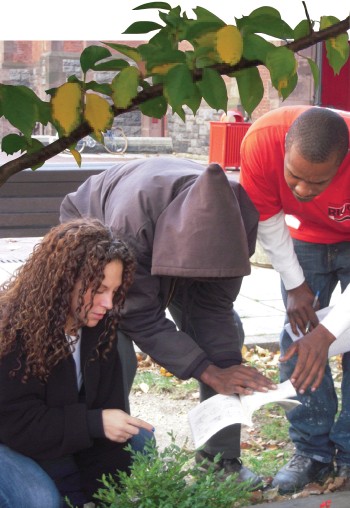NEW YORK CITY

Participants of CUCE-NYC's urban environment program learn about the importance of vegetation to a healthy ecosystem. Here they learn how to identify a plant using an ID key. See larger image
A tree grows in Brooklyn – but with help from volunteer urban foresters
Trees not only can help improve mood, concentration and the ability to recover from illness but also can help reduce stress, promote a sense of community and perhaps even help deter crime, report various studies. They also benefit communities by helping to reduce energy costs, decelerate climate change, manage storm water and increase property values.
Trees are so important for the health and well-being of New York City residents, their communities and environment that Cornell University Cooperative Extension-NYC (CUCE-NYC) and Cornell's Department of Natural Resources have joined forces in a pilot program to provide urban forest education workshops in Jamaica, Queens, and Canarsie, Brooklyn.
The goal is to enlist residents and organizations to become stewards of their community's trees and, ultimately, to develop resources to help groups around the country do the same, says CUCE-NYC senior extension associate Gretchen Ferenz, who co-leads the project.
Although such cities as Los Angeles, Salt Lake City, Houston and New York have large-scale tree-planting programs, their "capital project funds will support planting and immediate care of trees for a couple of years, but costs for longer term care to ensure a young tree's growth often are not included in municipal budgets," says Ferenz. "As a result, many urban trees do not survive into maturity."
The Urban Forestry Community Engagement project aims to change this.
First, the project team surveyed more than 800 residents "on the street" and in focus groups in Jamaica and Canarsie – where young trees were recently planted and resident involvement in tree care is needed – to learn about people's motivations, values and interests regarding urban trees and tree care.
"We learned that many residents surveyed did not feel that they should be responsible for taking care of trees; they viewed that as the responsibility of the parks department," says Shorna Broussard Allred, Cornell associate professor of natural resources and project co-leader. "However, we also found that nearly 60 percent were interested in learning more about trees – especially about the health benefits of trees along with tree planting, tree identification and tree care."
This fall, project staff began teaching free sessions in Jamaica and Canarsie about the role of trees in the urban environment. One activity being tested, for example, is "Neighborhood Tree Exploration," which allows residents to see their neighborhoods from a "green assets" perspective. Other topics included soils, selecting species, identifying plants, understanding species and age diversity, invasive species and wildlife.
As a result of the workshop, participant Mike Steffens, a volunteer forest steward, organized a volunteer tree care project to introduce residents to the natural areas of Canarsie Park that are being reforested. This kind of networking between local groups and residents, which helps ensure that community education programs have lasting impact, are being studied as part of the project.
"Cornell's urban forestry project is a useful and important community project that engages people and local residents in creating green spaces in areas that otherwise would simply be 'concrete jungles,'" says N.Y. Sen. John Sampson, who has helped support and promote the project. "Projects like these will help to reduce our carbon footprint."
Partners include the New York City Department of Parks and Recreation, U.S. Forest Service, Alliance for Community Trees, MillionTreesNYC and Trees New York; funding was provided in part by the Ittleson Foundation.